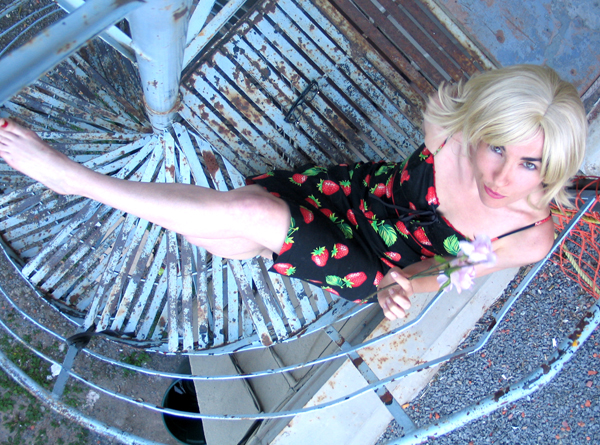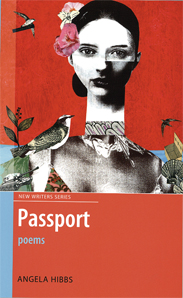Part of the Montreal
Fall Books Spectacular
Passport
by Angela Hibbs
DC Books, 2007
Monster Island Three
Various contributors, edited by Billy Mavreas
Conundrum Press, 2007
Thumbscrews
by Natalie Zina Walschots
Snare Books, 2007
Reviewed by Nathaniel G. Moore
*
 [Photo
by Mary Williamson] [Photo
by Mary Williamson]
In Passport, Montreal poet Angela Hibbs writes “I am a Chevette/ in a Cadillac body.” This debut poetry collection is a relentless mudslide into the uncharming world of dysfunctional emotional garrisons:
family, personal vanity, identity, obsession and corporeal investigation.
Hibbs works through family unfamiliarity and estrangement without sounding like the histrionic entries of a teenager’s diary. It’s the sophistication of her stance on topics of identity that solidifies a confident residue, one that remains long after reading the work. It’s the kind of poetry worthy of emulation.
Vision III
I call out my mother’s name in my
sleep. The tingle of space heaters
coming to; Jaime says I bore her. I
am too Dutch, all I do is complain
Of scalp pain and set rabbit
traps. With boiled spoons, I
brand her. She chases me with a
huge shiny corkscrew. I lock myself
in the bathroom. She calls her
warty maid by name.
XXXXXXXXXXXXXXX Music pours into
the living room, alters the blank
white tiles.
 Poems that strangle body image, sexual desire and persona and express a crisp depression and oppression, teetering on the absolute, the annihilation of trust.
Passport declares: “Empty is relative” and urges the reader to delve deeper into their psyche, beyond the instant gratification of what is a quick genre to “conquer” as in, the reader has read a poem. Congratulations reader, you read a poem. Now what?
Poems that strangle body image, sexual desire and persona and express a crisp depression and oppression, teetering on the absolute, the annihilation of trust.
Passport declares: “Empty is relative” and urges the reader to delve deeper into their psyche, beyond the instant gratification of what is a quick genre to “conquer” as in, the reader has read a poem. Congratulations reader, you read a poem. Now what?
The mood is developed to a feverous arousal; one can’t help but feel these pieces are all particles in a disturbed pathology. Hibbs fights for your attention, rarely shortchanging the reader with poetry glow-trend wordplay/foreplay. Instead, a deeper dig twists in the reader: “the fresh smell after an eternity of canned,” where the poet, we assume continues and shares a pose of loneliness and perhaps satisfaction: “I poured water morning and night / from a round jug / if there is belonging, I belong to this.”
Passport searches the world for meaning and shows us how oppressed we are. It is a verdict, a defense mechanism for a writer who isn’t given enough space to scream, but does so with eloquence and vigor.
*
Monster Island Three
Various contributors, edited by Billy Mavreas
Conundrum Press, 2007
A book work which dangles itself between comic anthology and art criticism, Monster Island
Three acts as a tour guide to strange gaggle of visual artists all camping out on the same netherworld of fantasy and creativity.
Contributors include: John Mavreas, Carlos Santos, Jesse Bochner, Tessa Fenger, Jennifer Macintyre, Shawn Jefferies, Guy Boutin, Helene Brosseau, Leyla Majeri, Rupert Bottenberg, Howard Chackowicz, Sean McCarthy, and Shawn Gheng.
Monster Island Three is edited by Montreal artist and guerrilla consultant Billy
Mavreas. He and publisher Andy Brown “talked about a fantasy version that would be big and full and all that good stuff that only perfect binding can provide.” And, after getting the go-ahead for the book, Mavreaus began gently pestering his friends and colleagues for pieces:
I was initially interested in artists who came from a Science fiction and fantasy background, sub-culturally but I knew I’d have to expand that if I was to include other artists I knew and liked.
Mavreas is toying with a 4th dimension of Monster Island, “maybe as a zine or a portfolio of prints or an audio tape, I’m not sure yet....but it will be a continuing project of things I am most interested in aesthetically lot of ground to cover.”
In many ways Mavreas has curated a masterful collection of what fan fiction experts classify as "Mary Sue" stories (fan fiction in which the author is a well-loved or possibly hero or heroine of the piece, or is rescued by the main character). Mavreas's artists identify deeply within the environment into which they are cast.
Mavreas went on to say he "discovered that each of the contributors here stars in his/her own origin story." And that is what is most important, I think, as an artist, to cherish and embellish that starting point of your creative consciousness, and continue to acknowledge and reinvent it.
On your spooky charter to Monster Island Three (the first two were in micro-zine format) don't forget to check out the eros-driven work from John Mavreas, Fiona Smyth, and the ink blots by Guy Boutin are worth taking to your psychiatrist. There are texts too, in the form of substantial essays by Patrick Burger who contributes a fascinating piece on German pulps set in Africa from the 1930s.
Andy Brown writes with passion on Jack Kirby's final comic series, while Rupert Bottenberg adds a humourous text/visual piece. Another clearing on the island full of wonder is Mavreas's feature on how he came to get hooked on the work of Iqaluit-born, Ottawa-based writer and visual storyteller Alootook Ipellie. Shawn Gheng’s work shall be classified as triple threat: pyschedilic, animalistic and anti-pedestrian. While Tessa Fenger's detail is intoxicating and mischievously elfish. It's hard to mention just a few of the over 20 artists who inhabit
Monster Island Three, if you know what I mean. It’s something you need to paw at for a while.
*
Thumbscrews
by Natalie Zina Walschots
Snare Books, 2007
 Thumbscrews is the winner of the 2007 Robert Kroetsch Award for Innovative Poetry Winner, beating out over 60 other manuscripts for the publishing deal. Says Snare of the book, "a poetic engagement with the aesthetics of sadomasochism and consensual pain."
Thumbscrews is the winner of the 2007 Robert Kroetsch Award for Innovative Poetry Winner, beating out over 60 other manuscripts for the publishing deal. Says Snare of the book, "a poetic engagement with the aesthetics of sadomasochism and consensual pain."
I have to admit initially skimming over the pared down work which appeared anorexic and undressed at first glance. It was when I reread the collection with a slight delay I saw where the leaps aimed, how the strides worked, and felt assured in the poet’s own footing. The voice is faced with an indelible lexical narcissism, engaging and magnetic: a system of recognition and associations, semblances of sensory attractions and definitions, where even syllables cause an associative repulsion.
The language here is largely, magnificent, unhealthy, gritty, moist, hedonistic and sadististic: never static or quotidian, but ready to play, to pounce and be pounced on. I love the paranoid nature of the copy on the back too, assuring us that the pain suffered or being suffered within the framework of the poems had a certain consent or sensuality going on.
As if we should take comfort in the notion that no poets were hurt in the creation of this work, which is a complete lie. It's the sort of set-up that makes Thumbscrews enjoyable, the formula for a mental/poetic imprint (or consequence) for each physical/primal act. The poems has filed down any traces of gushing doom or Emo whine to something brainy, ballsy and aggravated.
Thumbscrews is no routine,
but accepts the pedestrian nature of our new-aged diet language and confronts it
with a minimalist's tease. The brainy innuendoes that monkey wrench the
sleaze with blushing or cringing killjoys are real, honest and clever, never
stifling or staggering the work, but instead infuse the landscape with quaint
reminders all of life's strange, awkward but natural swerves.
|
